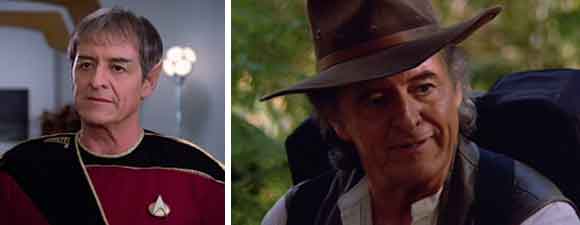Retro Review: The Inner Light
7 min readAfter being caught in a probe’s energy beam, Picard awakens to find himself living on a distant planet.
Plot Summary: The Enterprise stops to scan an unknown probe, which emits a particle stream that penetrates the shields and knocks the captain unconscious. Picard wakes to find himself on a planet in a house he’s never seen with a woman who claims to be his wife. She tells him that his name is Kamin and that he has been very ill, which has affected his memory. When he goes searching for some sign of the Enterprise, Picard meets a local council member, Batai, who calls Kamin his friend and explains that his wife, Eline, has been caring for him during his illness. They are on the planet Kataan, where Kamin is an iron weaver who enjoys playing the flute. Back on the ship, Riker and Crusher discover that the particle stream is keeping Picard unconscious but otherwise does not seem to be damaging him. Picard’s consciousness has jumped five years ahead on Kataan, where Kamin is concerned about the drought afflicting his planet, though he is also still searching the skies for the Enterprise. Eline expresses her unhappiness at having a husband who wishes he were elsewhere. Chagrined, Kamin apologizes and tells her that he would like to have a child with her. When his emotional experiences cause a physical reaction in Picard, Worf and LaForge try to separate him from the particle stream, but his pulse drops and Crusher insists that they reestablish the connection. Meanwhile, Kamin has two children and has become sufficiently skilled on the flute that he plays it at his son’s naming ceremony after his friend Batai, who has died. The drought on Kataan has grown much worse. When Kamin’s older child – a daughter who has become a scientist – realizes that the planet is dying, he urges her to marry and find happiness while she has the chance. Kamin visits planetary administrators with suggestions for combating the drought and learns that the leaders have known for many years that the planet is doomed. Back on the Enterprise, LaForge and Data have traced the probe’s origins to Kataan, but that planet’s sun went nova a thousand years before. In Picard’s mind, Kamin experiences the death of Eline and the birth of a grandchild. Now an old man, he is dragged by his family to see the launch of a missile which his daughter tells him he has seen before. Batai and then Eline reappear to tell him that the missile carries a probe which they hope in the future will encounter someone who will learn about their civilization and teach others about them. The particle stream terminates and Picard wakes on the Enterprise, learning that he was only unconscious for twenty minutes. Later, Riker visits him to tell him that an object was found on the probe. It is Kamin’s flute, which Picard remembers how to play.
Analysis: Unsurprisingly, “The Inner Light” is consistently rated one of the best if not the single best episode of Star Trek: The Next Generation. It has a simple, moving story, a near-total lack of technobabble, and an unforgettable performance by Patrick Stewart – this, far more than the soppy future with children and Christmas trees from Generations, is a life one can see Picard choosing if he weren’t already a starship captain. It’s interesting that this is a beloved episode of a science fiction series because it’s only barely science fiction; with only a few changes, it could be a magical story about a time traveler cast into a different era on Earth, something akin to The Time Traveler’s Wife. I’m not sure whether any of the writers ever confirmed that the title was taken from the Beatles song of the same name, but for anyone familiar with that song’s lyrics (“The farther one travels/The less one knows/The less one really knows”), the parallels seem obvious. Though he is overjoyed to find so much of his life before him, when he finds himself on the Enterprise once more, Picard also seems bereft, unsure how to fit these new sharp memories of half a lifetime into the familiar role and persona of the starship captain.
Kamin and Picard are sufficiently alike in many ways that Kamin’s life is a good fit. Though we’re told that by trade, Kamin is an iron weaver, presumably a craftsman, yet it is clear that he is interested and well educated in scientific theory, a passion he teaches his daughter just as he teaches his son to play the flute. The woman he has married is very no-nonsense yet at the same time devoted to nurturing; if Eline has a career, we never hear about it, though it’s hard to imagine that she sat around waiting for Kamin during the years before they had children, while he was still seeking some indication about how he got to Kataan and what happened to the Enterprise. They have a comfortable relationship in which she jokes about his lack of musical talent and repeated failure to put away his shoes. Like Jenice Manheim, she seems content to be the wife of a brilliant if difficult man, whereas Kamin’s daughter is a fellow scientist who chooses to marry and have children young primarily because she knows she won’t have a chance to do so later. Kamin’s son – who is played by Patrick Stewart’s son Daniel – isn’t nearly so focused, dividing his interests between mathematics and botany before deciding to leave school to concentrate on music, and it’s easy to imagine Picard just as annoyed with a young adult as Kamin becomes about this – his impatience reminds me a bit of how Picard has treated Reg Barclay and Wesley Crusher on different occasions. We never learn enough about the probe to know exactly how much is scripted and how much adaptive to the personality of the person who encounters the particle stream; did the people of Kataan get lucky that it’s Picard, or did they guess correctly what the personality of an explorer who might find their archive would be like?
Kataan is an interesting planet, which we as viewers explore in only small glimpses. It must be very peaceful, because people never start killing each other over the increasingly scarce water, not to mention the shortages of food and other necessities that must follow. Kamin never leaves his small town for any larger, more central place where his proposal for atmospheric converters might fall on more receptive ears, though perhaps this is because no such place exists, or perhaps the people of Kataan didn’t bother to detail their administrative trivia in this probe designed to give whoever encounters it a taste of ordinary life for an ordinary person. If our view of the planet seems idealized, it can be explained as a function of how the people chose to present themselves. We can’t know for sure whether Eline and her children were real people or whether they’re composites designed and programmed for whoever finds the probe. Yet this pre-warp civilization, that apparently didn’t even realize the imminent nova of its sun was the reason its planet was dying, constructed a device capable of controlling whoever found it – with all its sophisticated technology, the Enterprise could neither turn it off nor separate Picard from the data stream without putting his life in danger.
“The Inner Light” isn’t my favorite episode of Next Gen only because I wouldn’t choose an episode in which most of the ensemble play such minor roles – to me, the tightly-knit crew is what makes the series such a standout, far more than the science fiction themes or special effects (though it should be noted that the aging makeup in “The Inner Light” is exceptional and was nominated for an Emmy Award). There are a couple of lovely moments after Picard wakes up when Riker and Crusher are expressing concern about him while at the same time trying to haul him to his feet and keep him looking professional in front of the crew, but for the most part, the scenes with the crew mostly serve as transitions while Kamin’s life jumps ahead several years – they all merely contribute their usual expertise, Crusher taking vital signs, Worf suggesting that the probe should be destroyed, LaForge discussing its technical specs, Data coordinating the scientific data. This is a showpiece for Picard, presenting not only the romanticized death throes of a civilization, but a road-not-taken for a man who might have loved life as a small-town craftsman, a husband and father, much like the life Picard’s own brother has chosen on Earth. No wonder he plays “Frere Jacques” when he’s first trying to learn to play the flute. The emotional impact here is not just that we’re made to care about the fate of an unknown civilization in the span of a television episode, but that we’re invested enough in Jean-Luc Picard to understand what this alternate life has meant to him, and in the end, to share his sense of loss.






